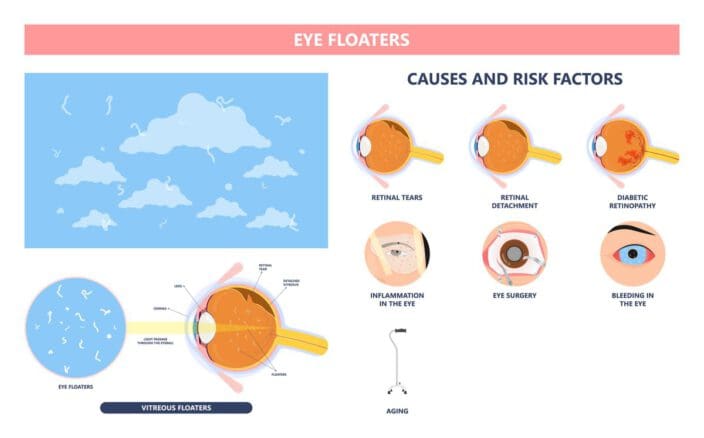Eye Floaters: Causes & Getting Rid of Them
Home /
Last Updated:
Eye floaters are small, gray or shadowy circles or lines in your vision created by clumps of protein that gather in the vitreous humor of your eyes. They can occur because of an underlying health problem, but more often, they are due to age-related changes.
Eye floaters are caused by changes in the vitreous humor, which is the gel-like substance that helps your eye maintain its shape. These changes can lead to exposure or tearing of your retina, which can cause a rapid increase in floaters that indicates a health emergency.
Mild cases of eye floaters are not treated, although your eye doctor will monitor them during your regular checkups. They may recommend lifestyle changes for these mild cases. Serious eye floaters may require a vitrectomy (removal and replacement of the vitreous humor) or laser treatment.
Ultimately, keep track of your eye floaters to help your eye doctor manage the health of your eyes.

What Are Eye Floaters?
Eye floaters are spots in your vision that track as your eyes move. They are typically benign and associated with age-related changes, but they can also indicate potential eye health problems like a rise in the fluid pressure in your eye.
Many people develop eye floaters. These are spots, rings, or web-like lines that are grayish, black, or shadowlike shapes in your vision.
You deserve clear vision. We can help.
With 135+ locations and over 2.5 million procedures performed, our board-certified eye surgeons deliver results you can trust. Your journey to better vision starts here.
You may not be able to look at them directly, but as you move your eyes, they will shift or drift back and forth. It may seem like these shapes are in front of you, but they are actually inside your eye, as they are particles in the vitreous humor that makes up the bulk of your eye. When they move in front of your retina, they block light so you can see them move back and forth.
Eye floaters are associated with the shrinking of the vitreous humor as you age, but they can also indicate potential problems with your eye health. Keep your optometrist or ophthalmologist informed about eye floaters, especially if you suddenly see a lot of them or their appearance is accompanied by light flashes, pain or discomfort, or nausea and headaches.
What Causes Eye Floaters?
To understand eye floaters, it can help to understand the structure of the eye. In a normal, younger eye, the vitreous humor has a gel-like texture.
With higher order myopia (nearsightedness), aging, some medications, chronic illnesses, and surgical procedures, the vitreous humor will change. The inside will become more liquid, and sometimes this is not thick enough to support the heavier gel on the outside. The internal changes can lead to some eye floaters, with more developing as the vitreous humor pulls away from the retina.
If you develop eye floaters, this is not necessarily a problem. Report them during your regular eye exam. This can help your optometrist or ophthalmologist to manage your eye health by monitoring for specific conditions. Common eye floater symptoms include:
- Small shapes that look like circles or lines in your vision but that you cannot look at directly.
- Spots that are noticeable on a plain or bright background, like a white wall or the sky.
- Shapes that move around if your eyes move a lot but eventually settle and move out of your line of vision.
These are normal, especially if you are middle-aged or older. However, you should see a doctor if eye floaters:
- Suddenly appear when you did not have them before.
- Multiply a lot very quickly, when you had only one or two before.
- Are accompanied by light flashes.
- Are accompanied by darkness or shadowing on the sides of your vision (peripheral vision loss).

The symptoms listed above indicate a tear in your retina, which may be due to retinal detachment, shrinking of the vitreous humor, or other causes. This necessitates immediate attention to avoid vision loss.
Among people who suddenly developed eye floaters, 39.7 percent had posterior vitreous detachment, and 8.9 percent had a torn retina, requiring immediate medical attention. About half of people who have a retinal tear will eventually develop retinal detachment if the problem is not treated.
Eye floaters can be caused by several conditions.
- Age: As you get older, the vitreous humor inside your eye shrinks, clumps, and gets stringy. Floaters are clumps of protein that accumulate in the vitreous humor as it changes.
- Nearsightedness: If you have had myopia for a long time, especially if your refractive error has consistently changed over time, you are more likely to develop floaters as your visual acuity impacts your retina.
- Migraines: Chronic headaches or migraines can lead to visual changes, including eye floaters.
- Surgeries or medication: Some types of medication and surgical procedures can lead to retinal damage, including tears, air bubbles causing exposure, or changes in the vitreous humor that will lead to eye floaters.
- Inflammation at the back of the eye: Posterior uveitis, inflammation in the uvea layers at the back of the eye, can release these clumps of protein into the vitreous humor. This may be associated with inflammatory diseases, infection, or other causes of damage.
- Bleeding in the eye: Hypertension, blocked blood vessels, diabetes, or injuries can cause bleeding inside your eye. You will register blood cells as floaters.
- Tumor: A tumor in or around the eye can put pressure on the area and cause changes within the structure of the eye, including to the vitreous humor and the retina. This can cause floaters.
- Torn retina: If your vitreous humor loses too much volume, it will pull away from the retina. This may lead to the retina being exposed to damage and tears, or the vitreous humor could pull the retina, leading to a tear. If this is not treated, it will lead to permanent vision loss.
Common Signs and Symptoms of Eye Floaters
You may notice the following signs when you have eye floaters:
- Tiny shapes when you gaze at a plain background like a blue sky or white wall. These shapes move as you move your eyes to look at something else.
- Images such as dark spots, hair strands, webs, or insects that move out of sight with your eye movement, especially in dim light.
Differences Between Floaters and Flashes
Floaters and flashes both have age-related causes and can occur simultaneously, but they are different. When you have eye floaters, you see objects that are not present.
In contrast, eye flashes usually appear as lightning streaks in front of your eyes, instead of seeing unreal objects like bugs or shapes. You may experience flashes when you rub your eye, stimulating the retina.
The light you see during those flashes is not real, either. When you pull the retina, your brain interprets the effect as a sighting of a star, a bright spot or lightning.
Unlike floaters, flashes can occur from a migraine, causing you to see heat waves or jagged edges. Occasionally, eye flashes can be frightening even if they do not threaten your long-term vision. Sometimes an episode lasts up to 20 minutes.
You deserve clear vision. We can help.
With 135+ locations and over 2.5 million procedures performed, our board-certified eye surgeons deliver results you can trust. Your journey to better vision starts here.
How Are Eye Floaters Treated?

Even if floaters are annoying, your optometrist or ophthalmologist will not treat mild cases. You should still report floaters to your eye doctor, so they can monitor your eyes for conditions like a torn retina.
When you report eye floaters to your doctor, they will ask you various questions, including:
- When you first noticed the floaters.
- What the floaters look like, including shape, movement, and when they occur.
- What refractive error you have, especially nearsightedness, and how serious it is.
- Whether the floaters occur in one or both eyes.
- Whether they are accompanied by other symptoms like flashes of light.
- Whether your eyes have other symptoms like redness, pain, or blurry vision.
- Whether you have ever taken certain medications or had certain eye surgeries.
- Whether you have a history of certain eye diseases or have had some types of injuries.
You may have some tests during an eye exam so your optometrist or ophthalmologist can diagnose any potential cause of the eye floaters. If you have enough eye floaters that your vision is impacted, or you have an underlying condition that requires treatment, you may receive one of two surgeries.
- Vitrectomy: This procedure eliminates eye floaters by removing the vitreous humor. Since floaters stay in this solution, an eye surgeon can remove the humor and replace it with a similar solution, allowing you to see clearly. If there is an underlying cause of these floaters that is not addressed, they will form again.
- Laser therapy: An eye surgeon can use lasers to break up these protein clumps in your vision. You may experience more floaters after this treatment because the clumps reform and multiply. For this reason, laser therapy is rarely used to treat floaters.
If you are interested in this potential treatment, talk to your eye doctor to ensure your eyes qualify.
Another avenue of treatment involves lifestyle changes. Try these to improve the state of your eye floaters:
- Eat healthily.
- Stay hydrated.
- Rest your eyes, especially if your work involves hours at a computer.
- Wear protective eyewear to prevent ultraviolet light damage.
When to See Your Doctor
See your optometrist or ophthalmologist immediately after you notice serious eye floater symptoms, because serious trouble can occur quickly.
Some complications associated with floaters can escalate and cause partial or permanent vision loss. In one study, 37% of patients with a retinal detachment experienced only a small number of floaters and light flashes (one to three) before developing a visual field defect (blind spot).
For most of those patients, it took about three weeks from the time of diagnosis to develop a loss of visual field.
Signs or symptoms to watch for include new floaters, floaters that come with pain or swelling and any acute eye trauma.
New Floaters
If you experience a floater for the first time, you should have your eyes checked by a specialist. It could be an indicator of an underlying condition like retinal detachment.
When your retina detaches from the tissue supporting it, your vision gets blurry day by day. You should not neglect this sign as it can eventually cause vision loss in the affected eye.
Let an ophthalmologist look at your eyes when you have a new floater. This gives you a good chance for proper diagnosis and early treatment, which can prevent retinal detachment.
Floaters With Eye Pain/Swelling
Sore eyes along with visual floaters may indicate a serious underlying condition. If you experience these two issues simultaneously, you may want to have your eyes examined for inflammation and infection.
These symptoms are common in people with uveitis, a condition that causes eyes to swell. Besides triggering visual floaters, uveitis may cause vision blurriness and redness in eyes.
People with autoimmune problems (where the immune system attacks the patient’s body) can also develop uveitis. As each patient is different, there is no telling how fast or slow these complications may worsen for you and cause permanent eyesight loss.
So you need to get help as soon as you spot the first serious signs, including recurring floaters accompanied by eye pain and inflammation. Note that, when it comes to uveitis, your entire body health may be at risk, not just the eyes.
Floaters and Eye Trauma
If you recently suffered injury to the eye and are now experiencing visual floaters, see your doctor right away. Your primary physician will likely refer you to an ophthalmologist, who can check your injured eye for inflammation or infection.
If you have had any eye surgery, you should let the specialist know too. Eye trauma after undergoing such a procedure can cause floaters and other severe medical conditions.
You deserve clear vision. We can help.
With 135+ locations and over 2.5 million procedures performed, our board-certified eye surgeons deliver results you can trust. Your journey to better vision starts here.
References
- Eye Floaters. (March 12, 2019). Mayo Clinic.
- Floaters. (July 2019). National Eye Institute (NEI).
- Eye Floaters, Flashes, and Spots. (March 2017). All About Vision.
- Eye Flashes and Floaters. Merck Manual: Consumer Version.
- Natural History of Posterior Vitreous Detachment with Early Management as the Premier Line of Defense against Retinal Detachment. (March 18, 1994). American Academy of Ophthalmologist.
- What are Floaters and Flashes? (September 24, 2020). American Academy of Ophthalmologist.
- What is Uveitis? (August 31, 2020). Ophthalmology Center Barcelona.
This content is for informational purposes only. It may have been reviewed by a licensed physician, but is not intended to serve as a substitute for professional medical advice. Always consult your healthcare provider with any health concerns. For more, read our Privacy Policy and Editorial Policy.